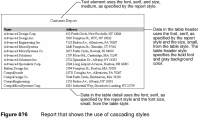Creating styles
BIRT Report Designer styles are a hybrid of CSS and Microsoft Word styles. You can use the following methods:

Create a named style, and apply it to a report element.
For example, you can create a style called ColumnHeading, then apply the style to all column headings in a report. This approach is like using Microsoft styles in that you create a Body Text style then apply this style to selected paragraphs.

Apply style properties to predefined style names, or selectors.
These predefined style names correspond to the different types of report elements. For example, you can apply style properties to a style called table-header, and all table headers in a report will be formatted accordingly. This technique is like using CSS in that you associate styles with HTML elements, such as <H1> or <P>.
You will find it useful to create styles using both techniques. The first technique is useful for creating specialized styles for different types of text content, such as important notes, offer notices, or copyrights. The second technique provides a powerful way to define style properties once for a container element and have those properties cascade to the container’s contents. For example, to apply a default format, such as the Arial typeface, to all elements in a report, apply the format to the predefined style name, report. After doing so, all text in the report appears in Arial.
Table 8‑7 lists the predefined style names for which you can set style properties.
Table 8‑7 Predefined style names
Predefined style name | Applies style properties to... |
chart | All elements in a chart. Use the predefined chart style to set general formats that you want to apply to all charts, such as boxes around all charts, or a particular font family to use as the default. To format each element in a chart, use the formatting options in the chart builder. |
crosstab | All parts of a cross tab, and all elements in a cross tab. |
crosstab-cell | Cross tab cells, including elements within them. |
crosstab-column-header | The part of the cross tab that displays the column headings, excluding the total headings. |
crosstab detail | The part of the cross tab that displays the aggregate values. |
crosstab-header | The entire row and column header area of the cross tab. |
crosstab-row-header | The part of the cross tab that displays the row headings, excluding the total headings. |
data | Data elements. |
grid | Grids, including elements within them. For example, if you specify a background color, the entire grid displays the specified color. |
image | Image elements. |
label | Label elements. |
list | Lists, including elements in them. |
list-detail | Detail area of lists, including elements in that area. |
list-footer | Footer area of lists, including elements in that area. |
list-group-footer-n | A specific group footer (1–9) in lists that contain groups of data. |
list-group-header-n | A specific group header (1–9) in lists that contain groups of data. |
list-header | Header area of lists, including elements in that area. |
page | The report’s master page. |
report | All elements in the report. The report is the topmost container. Any formatting you set for this style applies to everything in a report. |
table | Tables, including elements in them. |
table-detail | Detail rows of tables, including elements in the rows. |
table-detail-cell | Cells in the detail rows of tables. |
table-footer | Footer rows of tables, including elements in the rows. |
table-footer-cell | Cells in the footer rows of tables. |
table-group-footer-n | A specific group footer (1–9) in tables that contain groups of data. |
table-group-footer-cell | Cells in the group footer rows of tables. |
table-group-header-n | A specific group header row (1–9) in tables that contain groups of data. |
table-group-header-cell | Cells in the group header row of tables. |
table-header | Header rows of tables, including elements in the rows. |
table-header cell | Cells in the header rows of tables. |
text | Text elements. |
text-data | Dynamic text elements. |
TOC-level-n | A specific level (0–9) in a hierarchical table of contents. For reports that contain groups of data, BIRT automatically creates a table of contents, which users can use to jump to different parts of the report. |
If creating styles using the cascading model, it is best to design a set of styles from the top-level container down. At the top level, define style properties that you want to apply to all elements, then add style properties at each successive level. For example:

Use the report style to specify a default font family and font size for the entire report.

Use the table style to specify a default font size and text alignment for all data in tables.

Use the table-header style to specify bold font and a background color for table headers.
Any element you insert in a table header inherits the style properties from the report, table, and table-header styles. Any element you insert in a table detail inherits style properties from the report and table styles. Figure 8‑6 shows the results of applying the cascading concept to styles.
Not all style properties cascade. For example, the background color, margins, borders, and padding properties do not cascade from a container to the elements within it. In these cases, cascading the style does not make good design sense. For example, it does not make sense to cascade border values because designs typically use different border values for different elements. A design might use a border around a table without using borders around rows, columns, cells, or elements in cells.
For details about each property, including the cascading rule, see the ROM Styles specification document, which is available at the following URL:
http://www.eclipse.org/birt/phoenix/ref/
